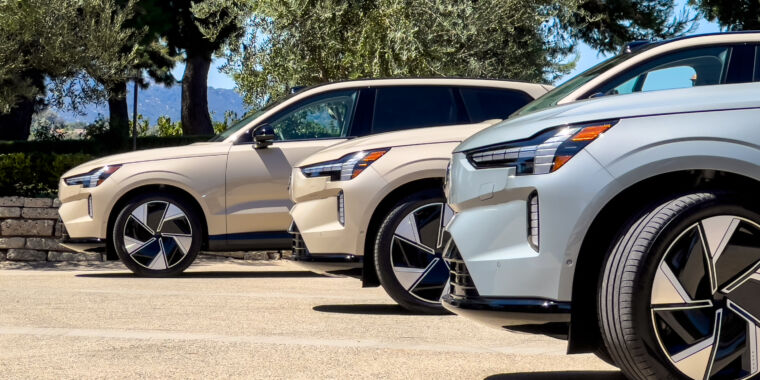Jonathan Gitlin
An early convert to the idea of an all-electrified lineup, Volvo has taken a slightly different tack to most other automakers as it electrifies its product range. Where most would start off with a big and expensive electric vehicle first, it did the opposite, starting out with small and affordable. That means it’s now time for a flagship EV, an all-new three-row SUV called the EX90, which we’ve driven ahead of US deliveries toward the end of this year.
That’s later than Volvo planned, and as you’ll see, some EX90 features have fallen even further behind and will need to be enabled via software update in the future. Because while the EX90 is a good demonstration of a new, tech-forward approach to car design, it’s also the latest example of automakers adopting the “minimal viable product” approach from the tech sector.
Volvo has developed an all-new platform for larger EVs, which the EX90 will share with other brands within the Geely group, notably the Polestar 3 we drove a few weeks ago. The Volvo is a little longer than the Polestar, and unlike the SUV from the upstart startup, the EX90 is a three-row, with seats for either six or seven depending on whether you opt for a bench or a pair of captain’s chairs for the middle row.

James Lipman/Volvo
The good
The SUV has a handsome, well-proportioned shape with some subtly creased angles, particularly around the rear wheels, although the roof-mounted lidar unit has led to comparisons with a London taxicab, and some of the test cars blended a little too effectively with the dry Southern Californian landscape courtesy of their beige paint. As we have come to expect from Volvo, there are a plethora of interesting design details inside and out, with plenty of storage nooks, grocery bag hooks, cup holders, and USB-C ports.
There are two powertrain options on offer with the EX90 for now, a $79,995 Twin Motor version with a combined 402 hp (300 kW) and 568 lb-ft (770 Nm) or the $84,995 Twin Motor Performance, which raises the power output to 509 hp (380 kW) and 671 lb-ft (910 Nm). In both cases, the rear electric motor is more powerful, with clutch-based torque vectoring that also allows the rear drive unit to completely disconnect the rear wheels for better coasting.
Both variants use the same 111 kWh capacity (gross, 107 kW useable) battery pack, sufficient for 310 miles (499 km) of range according to the EPA test cycle. Recharging the pack takes as little as 30 minutes to go from 10 to 80 percent state of charge with a DC fast charger (peaking at 250 kW), or 15 hours to charge from 0 to 100 percent SoC with a 32 A level 2 charger.
Volvo brought only the EX90 Twin Motor Performance to Newport Coast for us to drive, and the cars were optioned with the $4,350 Ultra pack, which adds active air suspension and massaging seats, as well as wireless phone charging. The standard Plus pack is already very well-equipped, but we’ll need to drive a few miles in one to see what effect standard coil springs and hydraulic dampers have on its ride.
-
The design is not revolutionary, but it is handsome.
Volvo -
There are two IR gaze-tracking driver-monitoring cameras—one in the steering wheel column and another at the base of the speaker in the middle of the dash.
James Lipman/Volvo -
The infotainment has a new UI. There’s a fixed row of icons at the bottom, then a row of contextual icons, then room for two user-defined widgets, with the map on the top two-thirds.
James Lipman/Volvo -
The middle row is a bench as standard.
James Lipman/Volvo -
The third row has very little legroom.
James Lipman/Volvo -
Volvo is getting more adventurous with its tail lights.
James Lipman/Volvo -
As with all three-row SUVs, the choice is passengers or luggage.
James Lipman/Volvo -
Volvo, unlike some other OEMs, is brave enough to bring a wool interior to North America. Synthetic leather is an option, but we’d pick wool.
James Lipman/Volvo -
Mirrors for humans, cameras for the car.
Jonathan Gitlin -
There is a frunk, but it is not very large.
Jonathan Gitlin -
If you choose the Captain’s chairs, they get in-arm cupholders.
Jonathan Gitlin
The adaptive air springs did a lot to hide this SUV’s considerable 5,688-lb (2,580 kg) curb weight. And the ride quality was notably good, particularly at highway speeds. The flip side was not-so-great body control over low-speed obstacles like potholes, road construction plates, and so on; side-to-side motions could be better controlled to stop the seat bolsters from performing percussive maintenance on your kidneys. You can also feel the torque vectoring at work, particularly in slow corners, adding a little extra agility to this big SUV.

